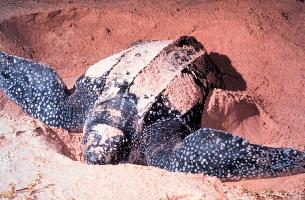
Weights and measures
| Length | 2 m |
|---|---|
| Weight | 600 kg |
State of endangerment
| Endangered |
Animal description
The Leatherback sea turtle (Dermochelys coriacea) stands out as a marvel of the marine world and is the largest of all living turtles. This majestic creature is not only the largest but also the deepest diving and most migratory of all sea turtle species, showcasing a unique blend of physical attributes and behaviors that distinguish it from its counterparts.Characterized by its large, streamlined body, the Leatherback sea turtle can grow up to 2 meters (6 feet) in length and weigh as much as 900 kilograms (2,000 pounds), though sizes vary. Unlike other sea turtles, the Leatherback does not have a hard, bony shell. Instead, its carapace is covered by a thick, leathery skin with embedded minuscule bone plates, giving it a somewhat flexible texture. This distinctive shell is predominantly black with white or light spots, aiding in camouflage in the deep waters.
The Leatherback's flippers are another notable feature. Exceptionally long and powerful, these flippers enable the turtle to travel vast distances across the oceans. Leatherbacks are known to migrate thousands of miles between feeding and nesting grounds, traversing the Atlantic, Pacific, and Indian Oceans. Their migrations are driven by their diet of mainly jellyfish, which they consume in large quantities. This diet is beneficial to marine ecosystems as it helps control jellyfish populations.
Leatherbacks possess several adaptations that allow them to dive to depths of over 1,000 meters (3,280 feet) in search of food, making them the deepest diving of all sea turtles. Their ability to regulate their body temperature enables them to tolerate colder waters, expanding their range far beyond that of other sea turtle species. This thermoregulatory ability is attributed to their large body size, high metabolic rate, and insulating layer of fat beneath their skin.
The reproductive behavior of Leatherback sea turtles is another area of interest. Females return to the beaches where they were born, often traveling thousands of miles, to lay their eggs. They dig nests in the sand with their flippers, deposit up to 100 eggs at a time, and then cover them before returning to the sea. These nests are left to incubate for about two months before the hatchlings emerge and make their perilous journey to the ocean.
Despite their fascinating biology and vital role in marine ecosystems, Leatherback sea turtles face significant threats from human activities. They are vulnerable to bycatch in fishing gear, marine pollution, coastal development, and climate change, which affects their nesting beaches and food supply. As a result, the Leatherback sea turtle is classified as Vulnerable by the International Union for Conservation of Nature (IUCN), and concerted global conservation efforts are underway to protect this incredible species and its habitat.
In conclusion, the Leatherback sea turtle (Dermochelys coriacea) is a remarkable creature that captures the imagination with its size, deep-sea diving capabilities, and extensive migrations. Its existence is a testament to the wonder of the natural world, and its conservation is crucial for maintaining the health and diversity of marine ecosystems.
New photos of animals
Top 10 animals
- Dolphin gull (Leucophaeus scoresbii)
- Diana monkey (Cercopithecus diana)
- Moustached guenon (Cercopithecus cephus)
- Galápagos tortoise (Geochelone nigra complex)
- Japanese macaque (Macaca fuscata)
- Russian tortoise (Testudo horsfieldii)
- Stone loach (Barbatula barbatula)
- Greek tortoise (Testudo graeca)
- Common flying dragon (Draco volans)
- Vendace (Coregonus albula)